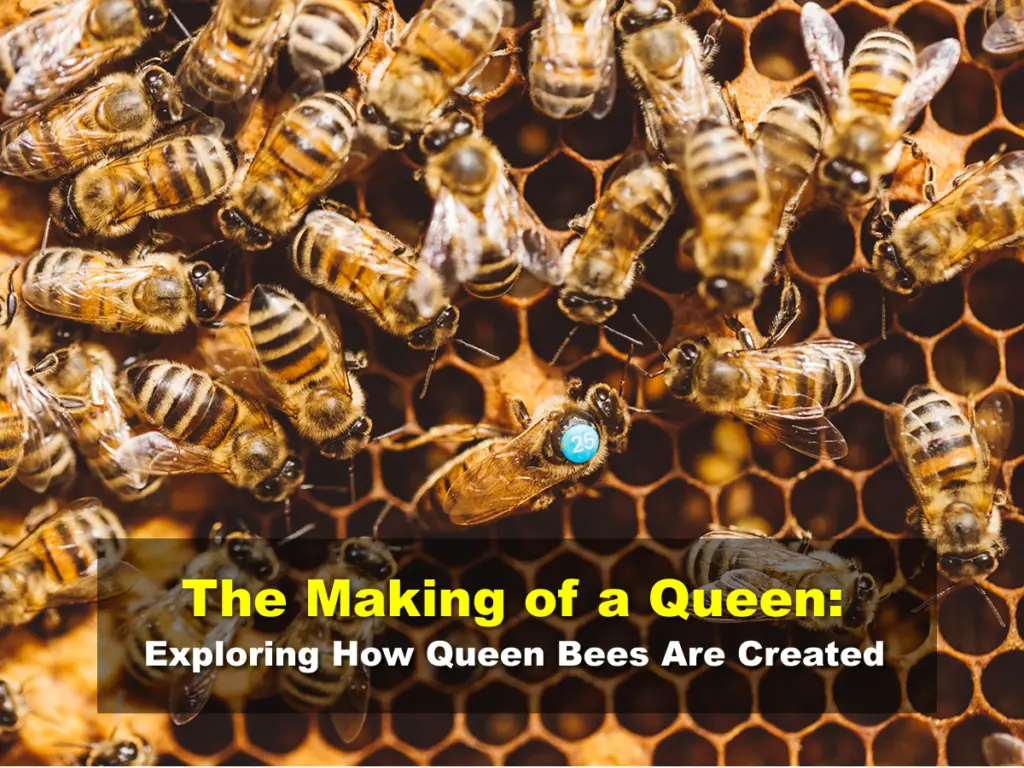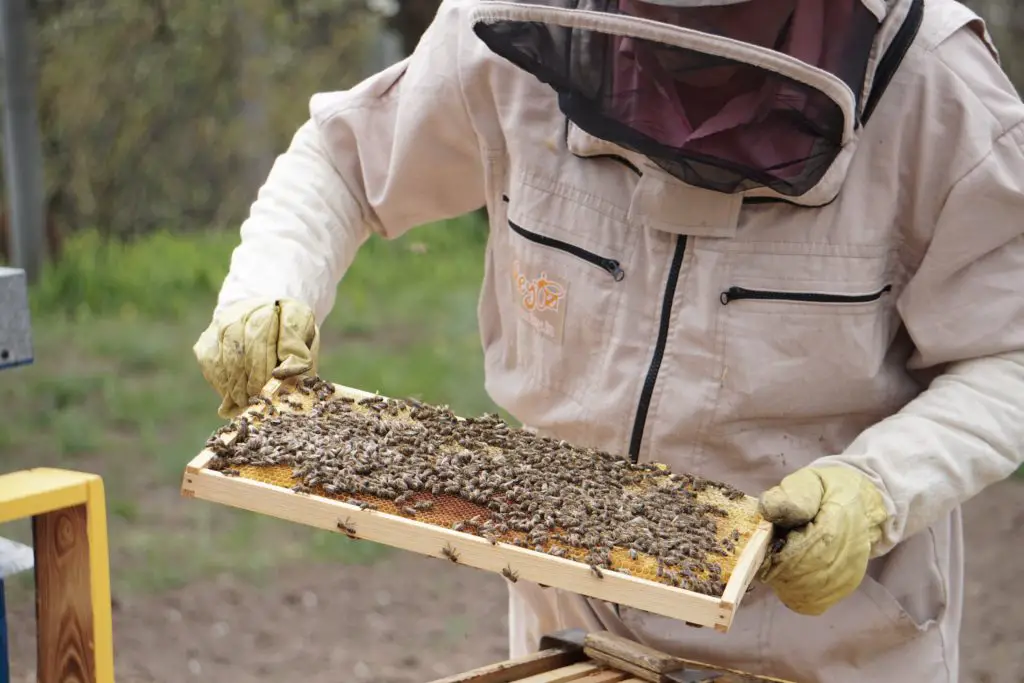Affiliate Disclaimer - As an Amazon Associate I earn from qualifying purchases.
It supports the website. So, Thank you
I think that most people are familiar with the idea that a honey bee colony always has a queen. The term queen bee is often used to describe a powerful and significant woman and that comes from the fact that the honey bee queen has one of the most impressive and powerful reigns in the insect kingdom. But how are queen bees made?
Honey bee queens lay an astonishing number of eggs over the course of their lives and each of these may stand a chance of becoming the new queen. Certain eggs are chosen to become potential queens and, when they hatch, they are fed on royal jelly.
But there is a lot more to this process and the queen is one of the most fascinating members of the colony. So, in this guide, I’ll discuss the making of the queen bee and why she’s such an important member of the hive.
Table of Contents
What Is The Purpose Of The Queen Bee?
The queen is the largest bee in the colony. Unlike the worker bees, the queen measures around 2 cm so she’s almost double the size.
All bees in a colony are incredibly important but the queen is perhaps the most important because it is her that is responsible for the very survival of her hive. She is the only female that will lay eggs so one of her main jobs is to mate with the male bees, known as drones. She does this only once in her life during her mating flight. After which, she will return to the hive and never leave again. The rest of her life will be dedicated to producing and laying eggs to keep the colony strong.
But this isn’t her only role. The queen is also an essential cog in the wheel of the hive as she uses pheromones to communicate with the other bees. These pheromones determine the behavior of the rest of the colony.
At times when the colony gets too large for its home or when there is a threat, it is the queen who is responsible for forming a swarm.
The Life Cycle Of The Queen Bee
There are male and female bees within the hive and any of the female eggs have the potential to become a queen. Whether or not this happens is directly down to the diet she is fed as a larva.
Honey bees are incredibly smart creatures and they have a sense that tells them when their current queen is nearing the end of her life. At this time, the female workers within the hive will start to raise new potential queens. But they don’t just choose one egg; there’s a healthy degree of competition and several female eggs will be chosen.
Normally, the nurse bees within the colony will choose anywhere from up to 20 female larvae to take care of and raise as new potential queens. They do this by feeding them royal jelly which is a white substance with a milky consistency that actually oozes from the tops of the bees’ heads. These specially chosen individuals will eat nothing else and the royal jelly helps them to develop a functional reproductive system; something that regular female worker bees do not possess.
When the queen lays her eggs in the honeycomb, she chooses special cells for new potential queens that look more like a peanut than a hexagon, like the other comb cells. Inside these cells is a ready supply of royal jelly.
The egg hatches into larva which remains in the cell with the royal jelly where it spends around 15 days growing and developing. Once this process is complete, the larva undergoes a metamorphosis and then it’s time for her to emerge. But just because this has happened, it doesn’t automatically make her queen. There’s still quite a battle to go.
The new potential queen, along with the help of several worker bees, starts to chew her way out of the cell and creates a little door to come out of.
What Happens Next?
Once the new potential queen has made her way out of the cell, the hard work really begins. As you may remember, she is one of around 20 new potential queens so if she’s going to reign supreme, she needs to fight off her rivals.
While honey bees are generally docile creatures, the battle to become queen is anything but. The new queen lets out a chirping sound to attract her sisters who respond by making a similar sound. This brings them together and, when they are gathered, the strongest new queen will sting all of the others to death so she can take her throne! Even if there are still some potential queen eggs that are unhatched, she’ll go to town on these as well, eliminating all competition.
After this ordeal, the queen needs to start thinking about mating. She is the only female within the entire colony that is able to mate so it’s time to get busy. The virgin queen exits the hive only once in her life and that is to take her mating flight. Just by mating with several drones during this one flight, she is equipped with everything she needs to produce fertilized eggs for the rest of her life, which could be anywhere between three and five years!
Once the mating flight is over, the queen goes back to the hive. In some cases, the old queen is still alive, although she won’t be in good health. The new queen needs to seek out her mother and kill her. However, in some cases, the previous queen may have gone off with a swarm, in which case, there’s no need for any bee homicide!
Now that she is settled into her new role, the queen will spend her days being looked after by the worker bees and laying eggs. She can be seen walking through the hive with a heavy abdomen filled with eggs as she goes in search of open cells in which to lay them.
The Death Of The Queen
As I have mentioned, a queen bee can live for anywhere between three and five years. Of course, this depends on the survival of the colony as a whole because it’s not uncommon for entire hives to die off during winter or because of disease.
But if she’s made it this far, it’s time for the queen to move over and make way for her successor. While there’s a good chance that she will be killed by her royal offspring, the old queen knows her duty and will start to release pheromones to let the rest of the colony know of her demise. Once they sense this, they will start raising new queens and the whole process starts again.
During the time that new queens are being reared, our current monarch doesn’t waste any time and she will continue laying eggs for as long as she is alive. Once the new queen has battled her way against her sisters, she will come in search of the existing queen and sting her to death.
Amazing Queen Bee Facts
The life of the queen bee and how she is produced is certainly a fascinating one. But these members of the colony never cease to amaze me. There are so many interesting things about them so let’s end with some queen bee facts.
- While a colony of honey bees could have tens of thousands of members (in some cases up to 80,000), there will only ever be one queen at a time. There are some very rare occasions where two queens may be present but this is only ever temporary.
- There may only be one queen in the hive but without her, the rest of the colony wouldn’t survive for very long. For this reason, bees are incredibly sensitive to the loss of a queen and within 15 minutes of losing her, they’ll pick up on this and start raising new potential queens.
- If you’re a beekeeper, you may think that it’ll be easy to spot the queen owing to her larger size but this isn’t always the case. In fact, it can be notoriously difficult to spot a queen among all those workers. Many beekeepers will buy a marked queen or will mark her themselves so it’s easier to keep track of her.
- A single queen honey bee can lay up to 1 million eggs throughout her lifetime. This is equivalent to laying anywhere between 2000 and 3000 eggs every day! That’s more than her own weight.
- When a honey bee colony senses that its queen is not performing as she should, they replace her in a process known as supersedure.
Final Thoughts
The honey bee colony could not survive without a queen which is why they’re so quick to raise a new one when the old one swarms or dies. But how are queen bees made?
The beginning of the process is pretty interesting, with several eggs being chosen to be raised as a new queen. But they aren’t all going to make it and it’s literally a fight to the death for the top spot.
New queens will sting their competitors to death before heading off to find the current queen and killing her off too. Once they’ve done this, they’re on a direct path to the same fate but not before they’ve laid as many as 1 million eggs to sustain the colony.




